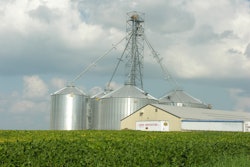The United Nations’ department of Economic and Social Affairs released a report in 2012 that the world’s population will reach an estimated 9 billion by the year 2050 (http://esa.un.org/unpd/wpp/index.htm). This estimate has placed a great deal of emphasis on agriculture and non-agriculture entities to determine the best way(s) to produce food for future generations. The current facts are that the amount of arable land to plow and sow is limited, and meat consumption is increasing as world economies evolve. Given the finite resources that are available for food production, technology will need to provide solutions for feeding an ever growing population. This is whyFeed & Grainhas partnered with AgGateway and the American Feed Industry Association (AFIA) to develop theInformation Technology Innovation Award. This award acknowledges work that is being done to make the process of putting food on the table more efficient and economical.
This year’s winner is Adisseo for its web-based platform, Precise Nutrition Evaluation (PNE;www.PNE.Adisseo.com). Precise Nutrition Evaluation is an innovative technology that combines an internet-accessible database with near infrared spectroscopy (NIR),in vivo(animal feeding studies) analyses of ingredients for the determination of apparent metabolizable energy (AME) and digestibility of amino acids (DAA), and ISO-certified wet chemistry methods that are both stringent and high-quality. Together, PNE delivers a more accurate, near-instantaneous nutritional analysis for the three most expensive nutrients within 25 feed ingredients (Table 1; AME for poultry, total and phytate phosphorus, and total and digestible amino acids for swine and poultry).
If we were to stop here and summarize the article below, Adisseo’s PNE service gives nutritionists, livestock producers, and feed manufacturers more control over the nutritional composition of their feeds. In addition, purchasing decisions can be adjusted based upon ingredient quality, thus providing a better, more economical match between nutrition vs. animal requirements for higher feed quality and more efficient food production. Rob Shirley and Steve Gately from Adisseo help explain below what PNE is and how PNE benefits the livestock industry.
Where does the livestock industry typically get its information on the nutritional composition of feed ingredients?
Prior to NIR, resources for determining the nutritional quality of feedstuffs were fairly limited, and for the most part based on word-of-mouth, tables, and wet chemistry. While suppliers, colleagues, and friends provide information word-of-mouth, books and magazines provide a reference of “table values” for the nutritional content of ingredients. Both sources are capable of providing guidance on the nutritional composition of ingredients; however, the data from each are for all intents and purposes inaccurate because they represent a snapshot in time, can be extremely dated, do not reflect continuously changing circumstances that lead to nutritional variation (i.e. type of cultivar, geographic region, weather, harvesting, storage, manufacturing process, etc.), and can be from a mixture of wet chemistry procedures that may be poorly defined and / or conflict with each other. To get around the uncertainty of the two previously mentioned resources and help ensure a certain level of animal performance, ample safety margins for key nutrient matrices are often built into formulations with the idea that it is better to have too much than too little. This over formulation strategy often costs money, and may not necessarily result in better animal performance.
In order to reduce the safety margins just mentioned, feed manufacturers and integrators can analyze the nutritional content of ingredients on a regular basis using wet chemistry andin vivoanalyses. The information that is generated is considered more dynamic and “real time” because it not only reflects analytical information that is generated on a regular schedule, but is also sometimes derived from actualin vivo(in life) feeding studies. As data are made available, they can be entered into a database to show trends over time. Unfortunately in any quality control program, analytical reports are often received days to weeks after the ingredients of interest are consumed by livestock; so any data that are received become a historical artifact. Putting this into perspective, Gately explained that “sending a sample out for metabolizable energy and digestible amino acids tests in the past would take you weeks and weeks to get an analysis back”. In order to turn these dynamic datasets into a more useful tool that report historical data in a real-time manner, near infrared spectroscopy (NIRS) has been adopted by many feed manufacturers and livestock integrators because it is rapid, reliable, accurate (depending on the reference wet chemistry), non-destructive, and relatively inexpensive. Today, in-house NIR equipment and Adisseo’s PNE have cut the nutrient analysis time of ingredients down to mere minutes.
What does PNE offer?
使用近红外光谱确定近似分析(protein, fat, fiber, ash, and moisture) for individual ingredients, and to a lesser extent mixed feeds, has been around for years. So when Adisseo started to work with NIR technology over 10 years ago, they knew they wanted to do something different and innovative. This is when PNE was conceived and developed.
“At Adisseo, we made the decision to take NIR one step further and develop DAA and AME calibrations. To do this, Adisseo had to put an extensive amount of resources into developing NIR calibrations and the PNE database," Gately noted. “As a result, Adisseo started testing ingredientsin vivo(living organism) at their research facility in Commentry, France (Figure 1) using the rooster assay for DAA and the three-week-old broiler assay for AME analyses. In a typical AME trial, three-week chicks are fed a complete diet and a diet where part of the common diet is replaced with the test ingredient. The excreta are then collected, freeze dried and analyzed for moisture, gross energy and nitrogen content. The comparison between the energy in the two diets vs. the respective excreta is made to determine the amount of energy (AME) that the bird was able to extract from the ingredient. The AME trial setup for each ingredient is replicated several times for statistical purposes, and is therefore a very laborious, time-extensive, and expensive possess.” This processes just defined have resulted in AME calibrations for corn, wheat and soybean meal, along with total and phytate phosphorus information for nine ingredients and total and digestible amino acid calibration equations for 25 ingredient types. Although this work has allowed Adisseo to launch PNE, they are far from done. Since its launch in September 2012, Adisseo has maintained its calibrations and expanded the number of ingredients they have digestible amino acid calibrations on from 19 to 25.
What are the processes that allow PNE to work?
我获得一个精确的分析的第一步s grinding. Grinding a sample ingredient to 1 millimeter (this is the same as 1,000 microns) reduces particle size and increases the uniformity of particle distribution throughout the sample that is scanned on the NIR; grinding also allows for a more complete penetration, reflection, and detection of light from the sample. It is very important that samples are not ground too fast, as this will overheat and change the nutrient composition of the sample. When the customer uploads a spectral file to PNE via the internet, the user defines the sample type, origin of sample and the analyses desired. Once the submit button is pressed in PNE, PNE compares the sample spectra to its core calibrations for the chosen ingredient and predicts (depending on the ingredient type) the AME, total and phytate phosphorus, and total and digestible amino acids within approximately 2-3 minutes. “When we first made Adisseo’s NIR service available to its customers (pre-PNE), it took two to four hours to turn sample spectra around into actual data. Today, PNE’s calibrations are encrypted in the cloud, analyses are returned within two to three minutes, and data are always available to the customer in case they want to create some trend charts for purchasing or nutrition-related activities” said Shirley. The near-instant turnaround time is unique to PNE, and has the ability to significantly change how feeds are formulated, ingredients are purchased and managed, and how feed cost is minimized.
What are the benefits of PNE?
After the drought of 2012, feed prices shot up to record breaking prices and highlighted how flexibility can be an asset when formulating feed. Amino acids, energy and phosphorus are the most expensive components in a feed formula, and Adisseo’s PNE gives accurate data for all three at the same time. This allows nutritionists to change the blend of feed ingredients and formula specifications, all while comfortably knowing that the formula will meet the nutritional requirements for healthy and efficient growth and production.
In order to validate the usefulness of PNE in production, "Adisseo has conducted a number of broiler performance trials, where book values were compared against PNE values for AME and DAA. In all the trials, improvements in feed conversion were consistently observed when nutrient values from PNE were used. These trials clearly demonstrate the biological and financial value of knowing the nutritional composition of feed ingredients," Gately says. Because PNE values are so accurate, PNE gives buyers and purchasing groups the ability to verify that what they are receiving is what they are paying for, and also check where the best value can be found. "If you look at the purchasing side of the equation, an integrator may have a number of suppliers to choose from. If a buyer is evaluating three distiller suppliers, the buyer has the option of ranking them according to how much digestible lysine is in each product. In addition, the amount of phosphorus and/ or AME from different soybean meal suppliers can be a criterion by which to rank soybean meal suppliers. At this point, buyers can start to rank the value of each supplier’s product based on what they traditionally deliver," Shirley remarks.
Summary of PNE
精度是必要的在任何科学和agriculture is a science that bases its productive output on cause-and-effect principals. As society continues to grow, agriculture must rely more on innovative technologies to efficiently improve food production. This is an unavoidable fact for a growing society that relies on agriculture to feed the world. In the case of swine and poultry production, knowing the nutritional makeup of feed ingredients is critical to formulating swine or poultry feeds that provide the correct nutrients, at the right levels, for the most economically efficient growth and production. Nutritionists, livestock producers and feed manufacturers that use Adisseo’s PNE platform have more control over nutritional decisions for their livestock, create better business opportunities on ingredient selection and purchases, and provide a better match between nutrition and production in terms of higher feed quality, more efficient production and better profitability.

.jpg?auto=format%2Ccompress&crop=faces&fit=crop&h=48&q=70&w=48)




















